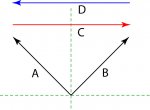gar
Senior Member
- Location
- Ann Arbor, Michigan
- Occupation
- EE
120319-1448 EDT
Jim:
To Besoeker you commented
Why did you come back with this response
Then you came back again with your comment on identities. How are VAN and VBN identities? If you are not considering these as identities, then why bring up identities?
Further in a newer post I believe I see you saying that there can not be a phase difference between the primary and secondary of a single phase transformer.
.
Jim:
To Besoeker you commented
Not really sure what you were saying in that statement. So I commentedThere is no progess unless you are finally admitting that the two halves of a single centertapped winding are IDENTICAL.
The number of voltage you derive are immaterial. The directions you arbitrarily assign are immaterial.
Van=-Vna=Vnb=-Vbn: It really is just about the equalities.
Van = 1 wave
Vbn = 1 wave
Vna = 1wave
Vnb = 1 wave
I my opinion in this thread there are those that are saying, at least, that these two voltages are the "same phase". Are "in phase" and "same phase" different or not, and if so, then how? Your direction of argument seems to put you on the side of VAN and VBN being of the "same phase".Anyone that is really familiar with circuit analysis will not classify VAN and VBN of a center tapped secondary as being "in-phase".
Why did you come back with this response
What does "A to N or B to N" have to do with my comment? These are simply two wire single voltage sources. A to B is from two voltage sources connected in series. Quite a different circuit.Please tell me who said it was.
You cannot connect terminal A to N or B to N without sparks either.
It is amazing how many posts have resulted from arguing points I have never made.
Then you came back again with your comment on identities. How are VAN and VBN identities? If you are not considering these as identities, then why bring up identities?
Further in a newer post I believe I see you saying that there can not be a phase difference between the primary and secondary of a single phase transformer.
This is nonsense no matter what your reference is, and how you interpret the reference. I can get either a zero or 180 degree phase shift from the input voltage to the output voltage of a single phase transformer with two isolated coils. If this was not possible you could not have both "buck" and "boost" applications.Draw the "equivalent circuit" of a single primary transformer winding and a single secondary winding. What references would you cite, to have Vsec be of a different phase than Vprimary? Why does IEEE/ANSI waste space in their 'standards' describing the relationship between X1 and H1 terminals?
.




